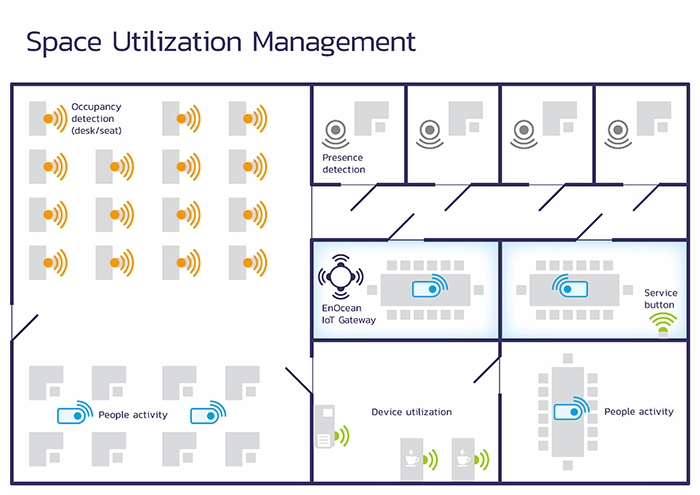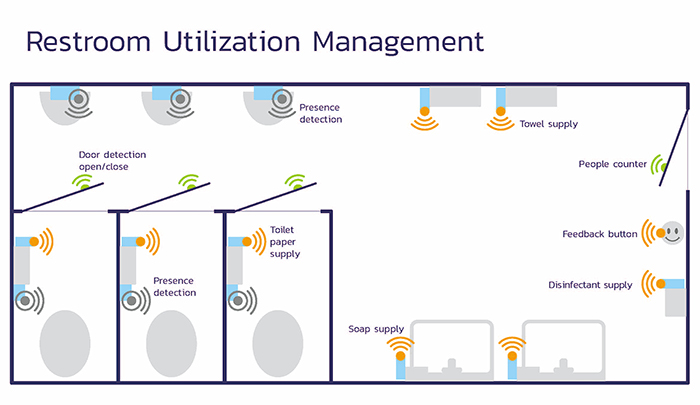Supporting safe and smart spaces
EnOcean Alliance, an international association of leading companies in the building and IT industries, has announced a major focus on supporting businesses and public sector organisations around the world to safely reopen following the widespread COVID-19 lockdown, using flexible, connected energy harvesting sensors to create safe and smart spaces. Initiatives will include webinars and training, as well as a pilot ‘Smart Spaces’ project package for an office environment.
Graham Martin, Chairman and CEO of EnOcean Alliance, explained: “Energy harvesting sensors are the ‘secret ingredient’ that can reduce the financial impact of reopening offices, restaurants, shops and schools whilst maintaining a safe distance between occupants, as well as very high standards of hygiene. The new requirement to keep workers safe and infection-free is completely in line with the established trends towards safe and smart spaces in buildings. The alliance and its members are already supporting these trends through the deployment of smart, connected and battery-free sensors, and will now pivot to support the creation of ‘safe and smart’ spaces. With energy harvesting technology, building managers can fit the sensor they want, where they want it and as requirements and regulations for space use change, add further interoperable sensors from other vendors.”
Taking the example of offices, Martin pointed out that the need to maintain social distancing put new pressure on office infrastructure. He said: “Companies will have to reduce the occupancy of their spaces. Making those spaces smart can mitigate the financial impact by ensuring that they are now used to their safe capacity, and serviced, heated and ventilated in line with actual usage.”
Joining the COVID fight
He pointed out that: “Pre-COVID research shows that up to 60% of desks are empty and meeting rooms are occupied less than 20% of the time. Removing desks that aren’t being used anyway, and repurposing underutilised meeting rooms, is a smart way to deliver a safe COVID-sensitive working environment. Similarly, by accurately monitoring actual usage of desks, meeting rooms and rest rooms, cleaning teams can be effectively directed to maintain high standards of hygiene in areas that have seen use, without dissipating time and energy cleaning little or unused spaces.”
Sensors based on EnOcean energy harvesting technology delivered by alliance members are cable-free, so are ideal for retro-fits and can be relocated at will, as facilities respond to the ever-changing coronavirus situation. They are also maintenance-free. Once set up they will work endlessly without the need to change the battery. There is a real RoI on these solutions. Pre-COVID estimates show that organisations can save 20% of their cleaning costs and 30% of their energy costs by implementing a smart spaces strategy. The alliance believes that these savings will be higher in the new, socially distanced, workplace.

To this end Dave Lister, CEO of EnOcean member IA Connects, explained that the company has been striving to debunk traditional BMS connectivity, simplify commissioning and connectivity, and offer a vision as to what sensing and connectivity should look like in the future and how we can make it more accessible and less dependent on heavily skilled engineers.
“We were the first company, in our previous iteration, to adopt EnOcean in the UK,” he said. “And we’ve been one of the longest standing partners and systems integrators in that EnOcean space. Some of our COVID-19-related use cases really illustrate the multi-functionality of our technology and the adaptability and flexibility of the systems.”
A catapult to efficiency
IA Concepts has presided over several projects to essentially make premises COVID-19-proof. This includes Digital Catapult in London, where the company installed NodeRed Dashboard, allowing employees to make an informed hot desk choice; desk occupancy sensors to show which desks are available; door and window magnetic contact sensors to show which doors and windows are open/closed;presence detection sensors for meeting rooms and communal areas; and a combination of temperature, humidity and air quality sensors which push alerts to the building and office managers informing them when levels are too high, and action needs to be taken.
Lister added: “When you have under-desk sensors that are already in place, and sensors that measure air quality, temperature levels, whether windows are open, and the ability to monitor people and places, you then have the flexibility of a system that can adapt to any challenge that comes along and obviously COVID is the biggest challenge of our of our generation.”
Therefore, the ethos behind the Digital Catapult project was to take what had already been installed and to advance it still further in order to deal with the current crisis. “They not only get live information, they have now got historical data to show how their spaces have been used in the past, and they can start to make some decisions accordingly,” added Lister.
Thinking big
While the Digital Catapult project was a small to medium sized application and served as something of a showcase piece for IA Connects, the company undertook a larger project in the US for a major utility company based in Florida, and have now installed the first 600 in a total of 3,500 under desk sensors.
Also installed have been IA Connects MobiusFlow Cloud Gateway, EnOcean Gateway Connectors, and IBM’s Building Insights Application. Lister added: “We supply the connection from the device data from all of these things to, in this instance, an enterprise level management system (IBM Building Insights) - so we pump the data straight from the devices directly through to the Watson Cloud, and they take the data from there and do their own analysis on what it is they are doing with their desks and how they are being used.”
Lister highlighted further the forward thinking nature of this company adding that they are one of the first companies to truly look at desk occupancy beyond the point of view of efficiency, but in terms of installing temperature sensors around certain spaces, and interacting with the workforce to understand who works better under certain conditions.
This has led the company to begin to allocate space based on the ambience of the area and the efficiency of the person in that area, rather than by company department.

Gatwick Airport has been a long-term IA Connects customer, providing all the lighting control for new installations. “Around 60-70% of the estate now runs on our systems, and wherever possible, we use EnOcean technology for the switching and sensing,” Lister added.
“We’ve used EnOcean very successfully in their offices. And they are really reaping the benefit at the moment because as airlines have begun to pull out due to COVID-19, office spaces that were previously let to the likes of Virgin and British Airways etc are now being repurposed.”
This means that the dynamics of certain buildings have changed dramatically in terms of usage, shape, size, and configuration. What’s made this transition that much easier is the limited amount of electrical interference and cabling involved. “The switches, PIRS and lux sensors just get taken down, put in a box while all the building work is carried out, and then we put them back up again afterwards - it really is that simple.”
Cleaning up
In light of the current COVID situation, this technology has also been applied to cleaning regimes to trigger on-demand cleaning. Lister added: “From simply adding PIRs, smart indicators and displays at a relatively low cost, all of a sudden people know how many people are in a washroom area at a given time – by monitoring people in/people out, providing door verification and door contacts.”
This means that washrooms can be cleaned when they need it rather than at a pre-designated time. As we move into the post-COVID era, solutions like these will provide businesses insights into their spaces and how they are being used.
“Companies that already have this are at an advantage,” added Lister, “because they have put in the baseline technology and connectivity that's required to facilitate additional sensors at a very low cost – they are then just looking at slight software modifications and some bespoke head end creation, which is minimal. These devices are multi-purpose, and they are applicable to any vertical.”
Meeting demand
As businesses seek to make their premises COVID-19-proof, with all the social distancing restrictions that entails, IA Connects has experienced a marked increase in demand for its solutions and has just gone through the busiest three months in the last two years.
Lister added: “By the beginning of February our quote books were about £250,000 to £300,000. By the time we hit the end of May our quote books were at about £1.5m. We have had inquiries from all over the world.
“It is worth reiterating that the reason we have been so popular is the fact we are offering something that post-COVID, still has an important job to do. It is not something you are going to spend £100,000 on and then throw it in the bin in six months. It is something that businesses are going to get huge benefit from as they move forward.”


